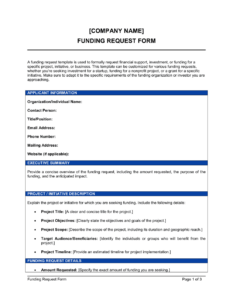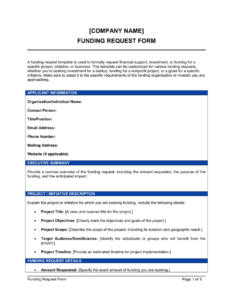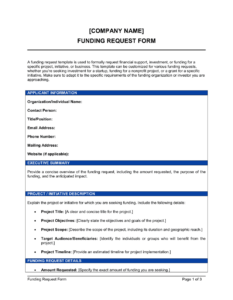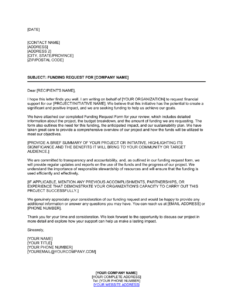Using a pre-designed structure offers several advantages. It ensures clarity and completeness, increasing the chances of securing funding. A well-crafted document also demonstrates professionalism and preparedness, enhancing credibility with potential investors or grant providers. Furthermore, it streamlines the application process, reducing the administrative burden on both the applicant and the funder.
This foundational understanding allows for a deeper exploration of related topics, such as developing compelling narratives, constructing realistic budgets, and identifying suitable funding sources. The following sections will delve into these critical aspects of securing financial support.
Key Components of a Funding Request Structure
A comprehensive funding request structure typically includes several key components, each serving a distinct purpose in conveying the project’s value and feasibility to potential funders. These components work together to present a cohesive and persuasive argument for financial support.
1. Executive Summary: A concise overview of the project, highlighting its key objectives, anticipated impact, and requested funding amount. This section should capture the funder’s attention and provide a compelling reason to read further.
2. Project Description: A detailed explanation of the project’s purpose, scope, and methodology. This section should clearly articulate the problem being addressed, the proposed solution, and the expected outcomes.
3. Needs Assessment: Justification for the project based on demonstrated need and supporting evidence. This section should establish the relevance and urgency of the project, highlighting the potential benefits to stakeholders.
4. Budget: A detailed breakdown of project costs, including personnel, equipment, materials, and other expenses. This section should be realistic, justifiable, and aligned with the project’s scope.
5. Evaluation Plan: A description of how project success will be measured and reported. This section should outline the metrics and methods used to track progress and demonstrate impact.
6. Organizational Background: Information about the organization requesting funding, including its mission, history, and relevant experience. This section should establish the organization’s credibility and capacity to manage the project effectively.
7. Sustainability Plan (if applicable): A strategy for ensuring the long-term viability of the project after the initial funding period. This section demonstrates foresight and commitment to lasting impact.
By incorporating these elements, a funding request offers a thorough understanding of the project, its potential impact, and the requesting organization’s capabilities. This comprehensive approach strengthens the application and increases the likelihood of securing financial support.
How to Create a Project Funding Request
Developing a compelling funding request requires careful planning and a clear understanding of the project’s goals and the funder’s priorities. A structured approach ensures all essential information is presented effectively, maximizing the chances of securing financial support.
1. Define Clear Objectives: Begin by clearly articulating the project’s purpose, scope, and intended outcomes. Specific, measurable, achievable, relevant, and time-bound (SMART) objectives provide a strong foundation.
2. Research Potential Funders: Identify funders whose priorities align with the project’s goals. Understanding their funding criteria and preferences is crucial for tailoring the request effectively.
3. Develop a Compelling Narrative: Craft a persuasive narrative that highlights the project’s significance, potential impact, and alignment with the funder’s mission. A clear and concise narrative captures attention and generates interest.
4. Construct a Realistic Budget: Develop a detailed budget that outlines all project costs, justifying each expense and demonstrating responsible resource allocation. A well-structured budget enhances credibility.
5. Design a Measurable Evaluation Plan: Outline a plan for measuring project success and demonstrating impact. Clear metrics and reporting mechanisms build confidence in the project’s potential.
6. Showcase Organizational Capacity: Highlight the organization’s experience, expertise, and resources relevant to the project. Demonstrating capacity builds trust and assures funders of successful project execution.
7. Consider Sustainability: Address long-term sustainability, especially for projects requiring ongoing support. A plan for future funding demonstrates foresight and commitment.
8. Review and Refine: Before submission, thoroughly review and refine the request for clarity, completeness, and accuracy. A polished document reflects professionalism and attention to detail.
A well-crafted funding request provides a comprehensive overview of the project, its potential impact, and the requesting organization’s capabilities. This structured approach enhances the likelihood of securing funding and achieving project success.
Standardized documents for requesting project funding provide a crucial framework for securing financial resources. They ensure clear communication of project goals, activities, budgets, and expected outcomes, increasing the likelihood of a successful application. The structured approach offered by these documents benefits both applicants and funders by streamlining the process and promoting transparency. Key components such as a compelling narrative, a realistic budget, and a measurable evaluation plan are essential for demonstrating project viability and organizational capacity. Careful planning and attention to detail in crafting these requests are crucial for maximizing the chances of securing funding and achieving project success.
Ultimately, effective resource allocation relies on clear, concise, and compelling communication. Leveraging structured frameworks for funding requests represents a significant step toward ensuring projects receive the support necessary to achieve their full potential and contribute meaningfully to their respective fields. This careful approach to securing financial resources empowers organizations to pursue impactful initiatives and drive positive change.



